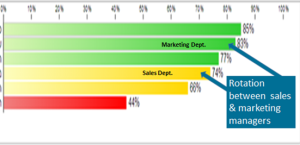[This article was written with Eng. Sarit Unger-Massiah]
Executive Job Rotation is a rotation between managers, without promotion. It does not require, necessarily, obtaining greater authority and/or responsibility, and/or financial reward. The organization's leadership uses it, in a structured and a planned way, as a management tool.
The easiest implementation of the Executive Job Rotation is in unprofessional bureaucracies, such as military organizations, dominated by the organization's bureaucracy. Although there are specific specialties in these organizations, usually there are no particular qualifications required for its managers, and they are acquired on the job. Therefore, the Executive Job Rotation can be applied easily (sometimes with the addition of certain conversion). For example, in the Police, an investigation officer can change position with a traffic officer; and conversely, and the organization trusts them to learn everything they need while working.
The more professional organizations are, the less ability they have to perform Executive Job Rotation. In professional bureaucracies such as courts, hospitals, etc. - where power is divided between a leading profession and the bureaucracy - there is a clear commitment to profession and specialization. Therefore, Executive Job Rotation can be applied only between similar departments in terms of their activities. Rarely, it is possible to appoint to a management position a person, who does not have the requires expertise. For example, in hospitals, the management can rotate the heads of the general surgery departments, but they cannot be replaced by the head of the Children's department.
Assuming that the conditions for executive rotation are optimal, When it is effective to perform it?
The organization's driving force is the dominance of its managers. Dominance is the combination of power and influence. It is the ability of an employee to motivate others to do what he wants - directly or indirectly - even if it contradicts their interests at that time. Dominance - like beauty and wisdom - is given sparingly, and only few share it. It is always measured in relation to others within the organization, and can be analysis and numerically measured by Organizational Network Analysis – ONA.
Organizational Network Analysis shows us that a dominant manager also influences his department's status. This is the key to an effective rotation: Transfering a powerful manager to a weak department, in order to raise its status as quickly as possible (and sometimes vice versa: Transfering a weak manager to a dominant department, in order to strengthen him).
Our first case study is an elite military unit, which placed the most dominant commander in the weakest platoon, in order to raise its status, and used ONA to trace the rotation results.
Right after the rotation, ONA diagnosis must be maintained as a baseline. The result will reflect an anomaly: the most dominant officer (see Table 1) commands the weakest platoon (see Table 2).
Table 1: Platoon no. 4 commander is the most dominant
Table 2: the most dominant officer commands the weakest platoon

Table 3: Platoons dominance, seven months later
The second case study is a business organization: The dominance of the sales manager is low, and the dominance of his department - the most important core department in the organization - is low respectively. On the other hand, the marketing manager is very dominant and dynamic. replacing them in this case is the right thing to do, but, not always the background of two managers can make the rotation between them possible.
Again, the success of rotation can be measured with ONA.
Table 4: Executive rotation in a business organization
Finally,
The driving force of the Executive Job Rotation, as a management tool, is the dominance of its managers.
Placing a dominant manager in weak core-department is the key to a successful implementation of the Executive Job Rotation.






